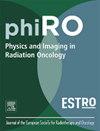头颈癌实施保留高危器官的适应性放射治疗的个性化政策的成本效益
IF 3.3
Q2 ONCOLOGY
引用次数: 0
摘要
背景与目的适应性放射治疗(ART)的原理是根据治疗过程中解剖结构的变化来调整放射计划。本研究的目的是建立一个实施个性化ART的决策模型,以平衡头颈癌(HNC)放疗计划适应的成本和临床效益。材料和方法利用52例HNC患者的回顾性影像学数据,建立马尔可夫决策过程(MDP)模型,根据计划剂量和给药剂量对高危器官正常组织并发症概率的差异(ΔNTCP)确定计划适应的最佳时机。为了捕获计划调整的成本和收益之间的权衡,将最终治疗ΔNTCPs转换为质量调整生命年(QALY),然后使用每个QALY参数的支付意愿转换为等效的货币值。结果得到了96种按质量质量支付意愿(W)和重新规划成本(RC)组合的最优策略,并通过蒙特卡罗模拟验证了两种代表性情景:(1)W = $200,000, RC = $1,000;(2) w = $100,000, rc = $2,000。在方案(1)中,MDP模型的政策以每位患者380美元的平均成本将过度毒性(ΔNTCP≥5%)的概率从0.21降低到零(未重新规划)。在场景(2)中,以每位患者520美元的平均成本将该概率降低到0.02。结论MDP模型的政策在临床和财务结果方面都优于当前的固定时间(一刀切)方法。本文章由计算机程序翻译,如有差异,请以英文原文为准。
Cost-effectiveness of personalized policies for implementing organ-at-risk sparing adaptive radiation therapy in head and neck cancer
Background and Purpose
The principle of adaptive radiation therapy (ART) is to adjust radiation plans in response to anatomical changes during treatment. The purpose of this study was to develop a decision-making model for implementation of personalized ART that balances the costs and clinical benefits of radiation plan adaptations in head and neck cancer (HNC).
Materials and Methods
Using retrospective imaging data from 52 HNC patients, a Markov decision process (MDP) model was developed to determine optimal timing for plan adaptations based on the difference in normal tissue complication probability (ΔNTCP) between planned and delivered doses to organs-at-risk. To capture the trade-off between the costs and benefits of plan adaptations, the end-treatment ΔNTCPs were converted to Quality Adjusted Life Years (QALYs) and then to equivalent monetary values using a willingness-to-pay per QALY parameter.
Results
The optimal policies were derived for 96 combinations of willingness-to-pay per QALY (W) and re-planning cost (RC) and validated using Monte Carlo simulation for two representative scenarios: (1) W = $200,000, RC = $1,000; (2) W = $100,000, RC = $2,000. In scenario (1), the MDP model’s policy reduced the probability of excessive toxicity (ΔNTCP ≥ 5 %) to zero (from 0.21 without re-planning) at an average cost of $380 per patient. In scenario (2), it reduced this probability to 0.02 at an average cost of $520 per patient.
Conclusions
The MDP model’s policies outperformed the current fixed-time (one-size-fits-all) approaches in both clinical and financial outcomes in the simulations.
求助全文
通过发布文献求助,成功后即可免费获取论文全文。
去求助
来源期刊

Physics and Imaging in Radiation Oncology
Physics and Astronomy-Radiation
CiteScore
5.30
自引率
18.90%
发文量
93
审稿时长
6 weeks
 求助内容:
求助内容: 应助结果提醒方式:
应助结果提醒方式:


